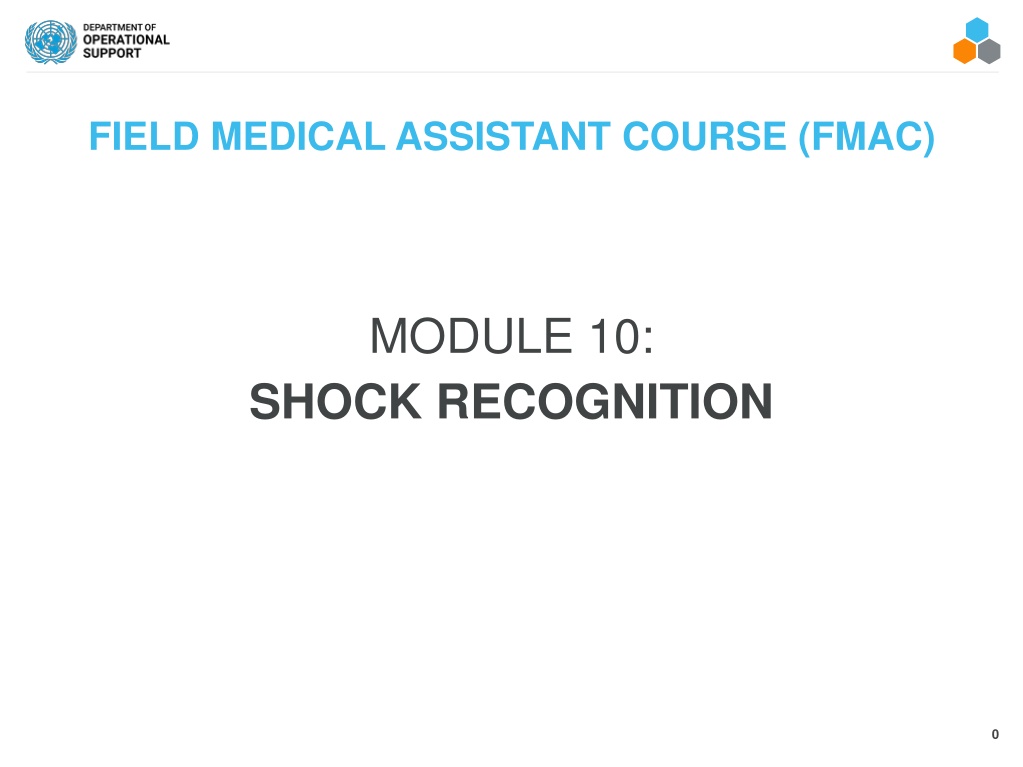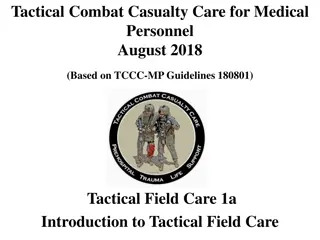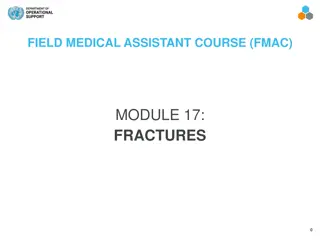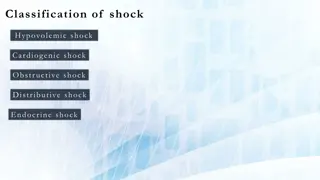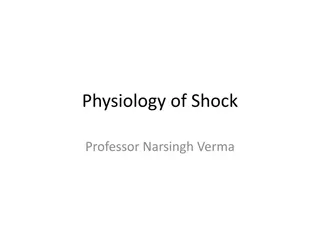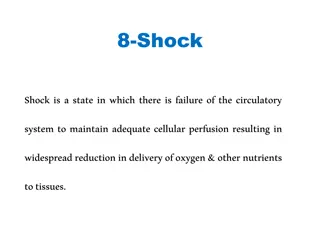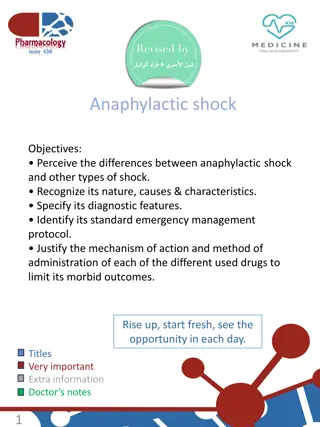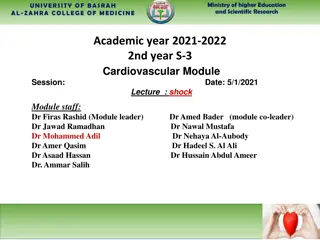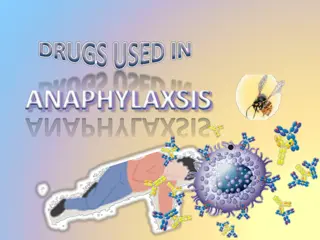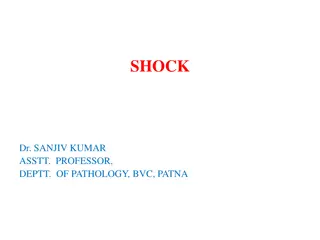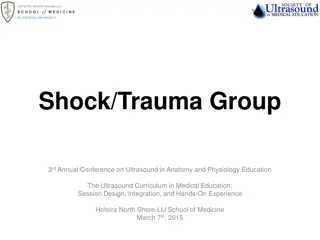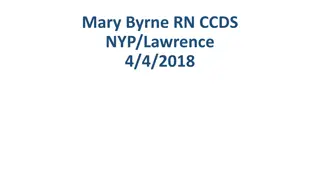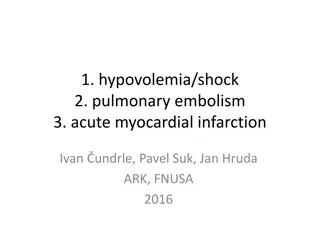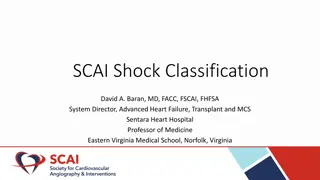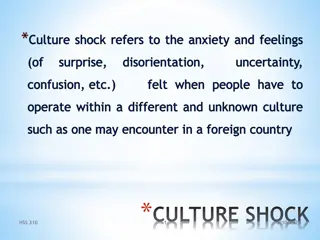Tactical Field Care - Shock Recognition and Management
Tactical Field Care emphasizes the importance of shock recognition and prompt intervention to prevent casualties on the battlefield. Understanding the signs, symptoms, and management steps of shock, particularly in trauma cases with life-threatening bleeding, is crucial for medical personnel. This module highlights the significance of assessing the level of consciousness and radial pulse as indicators of shock in Tactical Field Care. Additionally, the content stresses the consequences of inadequate blood flow in the body tissues and the critical need for quick recognition and treatment of shock to prevent fatalities.
Download Presentation

Please find below an Image/Link to download the presentation.
The content on the website is provided AS IS for your information and personal use only. It may not be sold, licensed, or shared on other websites without obtaining consent from the author. Download presentation by click this link. If you encounter any issues during the download, it is possible that the publisher has removed the file from their server.
E N D
Presentation Transcript
FIELD MEDICAL ASSISTANT COURSE (FMAC) MODULE 10: SHOCK RECOGNITION 0
TACTICAL FIELD MEDICAL AID (TFMA) ROLE-BASED TRAINING SPECTRUM ROLE 1 CARE NONMEDICAL PERSONNEL Buddy First Aid Field Medical Assistant You are HERE MEDICAL PERSONNEL Paramedic Nurse Doctor 1
STUDENT LEARNING OBJECTIVES TERMINAL LEARNING OBJECTIVE T11 Describe shock assessment in Tactical Field Care in accordance with TFMA Guidelines EO63 Identify the signs, symptoms, and management steps of shock in a trauma casualty with life- threatening bleeding EO64 Identify the importance of level of consciousness and radial pulse as indicators of shock in Tactical Field Care 2
TACTICAL FIELD CARE MARCH PAWS DURING LIFE-THREATENING AFTER LIFE-THREATENING MASSIVE BLEEDING #1 Priority PAIN AIRWAY ANTIBIOTICS RESPIRATION WOUNDS CIRCULATION SPLINTING HYPOTHERMIA / HEAD INJURIES 3
SHOCK RECOGNITION SHOCK RECOGNITION Video can be found on DeployedMedicine.com 4
CIRCULATION/SHOCK SHOCK Shock is inadequate blood flow to body tissues. Inadequate blood volume inside the circulatory system results in inadequate oxygen delivery to the body s cells As cells cease to function, tissues cease to function, then organs cease to function, and eventually the wholebody will fail and DEATH follows IMPORTANT CONSIDERATIONS: Shock will lead to the casualty's death if not quickly recognized and treated 5
CIRCULATION/SHOCK SHOCK Caused by a decrease in the amount of blood volume circulating in the casualty's blood circulatory system Shock can have many causes low blood volume or hypovolemia (dehydration or blood loss), low blood pressure (massive infection), heart failure, or neurologic damage Usually caused by severe bleeding, but it can also be caused by severe burns (second- and third-degree burns on 20 percent or more of the body surface) On the battlefield, assume shock is from severe blood loss (also called hemorrhagic shock) Hemorrhagic shock can result in the casualty's death M A R C H 6
CIRCULATION/SHOCK GENERAL INDICATORS OF SHOCK SIGNS AND SYMPTOMS OF SHOCK INCLUDE: Mental confusion Weak or absent radial pulse Rapid breathing Nausea Excessive Thirst Sweaty, cool, clammy skin Previous severe bleeding Pale/grey skin M A R C H 7
CIRCULATION/SHOCK GENERAL INDICATORS OF SHOCK IMPORTANT Indicator: Mental confusion IMPORTANT Indicator: Weak or absent radial pulse If BOTH indicators exist, the casualty has lost a SIGNIFICANT amount of blood As previously stated, shock will lead to the casualty's death if not quickly recognized and treated 8
CIRCULATION/SHOCK GENERAL INDICATORS OF SHOCK Blood Volume Blood Loss Signs/Symptoms Effectme 4 liter bottles full, 1 bottle1/2 empty 500cc Possible increased HR Usually no effects 4 liter bottles full, 1 empty 1000cc Radial pulse >100 Breathing probably normal Unlikely to die from this amount of loss 31/2 bottles full, 11/2 empty 1500cc Change in mental status Weak radial pulse >100 Increased respirations Still unlikely to die 3 bottles full, 2 empty 2000cc Confusion and lethargy Very weak radial pulse >120 High respiratory rate >35 Very possibly fatal if not managed 21/2 bottles full and 21/2 bottles empty 2500cc Unconscious No radial pulse, carotid pulse, HR >140 Respirations > 35 Fatal without immediate and rapid interventions M A R C H 9
CIRCULATION/SHOCK PREVENT SHOCK BY CONTROLLING BLEEDING #1- Reassess to confirm all bleeding control measures are still effective It is better to prevent shock with hemorrhage control than to treat it If shock is present, though, the most critical first step is to control the bleeding Internal bleeding from chest or abdominal trauma may not be controllable, and shock may develop later, so continuously assess the casualty Medical personnel will provide other treatments, but you can save them time if extremal bleeding is controlled Ensure TQs and pressure dressings remain tight Check radial pulse DO NOT WAIT for signs and symptoms of shock to occur M A R C H 10
CIRCULATION/SHOCK ASSESS/MONITOR FOR HEMORRHAGIC SHOCK Assess for signs and symptoms of shock as soon as hemorrhage is controlled, the airway is open, and respirations have been managed The best indicators of shock are a decreased state of consciousness (if casualty has not suffered a head injury) and/or an abnormal, weak, absent radial pulse Assess for hemorrhagic shock (altered mental status in the absence of brain injury and/or weak or absent radial pulse) Reassess/monitor for changes in the level of consciousness by checking for alertness or responsiveness to verbal or physical stimulation M A R C H 11
SHOCK RECOGNITION REASSESS Level of consciousness Check casualty every 15 minutes for AVPU Alertness - Knows who, where they are Verbal - Orally responds to verbal commands Pain - Level of pain felt when the sternum is briskly rubbed with the knuckle (if needed) Unconscious - Unresponsive Decreasing AVPU could indicate condition worsening Breathing rate Monitor respirations Thoracic trauma may indicate tension pneumothorax (needle decompression of the chest required) If a casualty becomes unconscious or their breathing rate drops below two respirations every 15 seconds, insert a nasopharyngeal airway 12
CIRCULATION/SHOCK SHOCK MANAGEMENT Place casualty in recovery position Fluids by mouth are permissible if the casualty is conscious and can swallow Evacuate the casualty if medical help is not available Reassess the casualty frequently for the onset of shock 13
CIRCULATION/SHOCK HYPOTHERMIA MANAGEMENT REMEMBER: Keep the casualty warm and prevent hypothermia. Even in very hot environments, a casualty in hemorrhagic shock (blood loss) is at EXTREMErisk for hypothermia Place a poncho or blanket under the casualty to protect from the temperature or dampness of the ground Cover the casualty with a survival blanket or other available materials to keep them warm and dry 14
SUMMARY We defined shock We identified indicators of shock We discussed prevention measures for shock We discussed the management of shock We introduced hypothermia IMPORTANT Indicator: Mental confusion IMPORTANT Indicator: Weak or absent radial pulse 15
CHECK ON LEARNING What is shock? What are the best indicators of shock? What is the most important action to prevent hemorrhagic shock? 16
